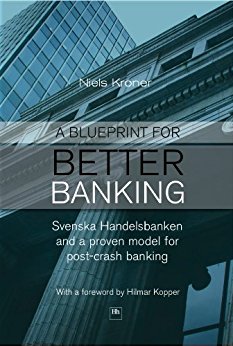Book review: “A Blueprint for Better Banking: Svenska Handelsbanken and a proven model for post-crash banking “

The author of the book is Nils Kröner, a German who among others worked as consultant at McKinsey, at Barclays and for AKO capital before he became professor.
The book has been written following the big financial crisis and starts with a review about what went wrong in general.
Then he introduces the “7 deadly sins of banking” that contributed in his opinion to the banking crisis which are:
- Asset/Liability mismatches
- Supporting Clients’ Balance Sheet mismatches
- Lending to Over-Indebted Customers
- Investing in Non-Core Assets
- Dealing with the Non-Bank financial System
- Münchhausen Markets: Emerging MArkets and Real estate
- The Continuity of the Past to the Future
“Normal” banks commit those sins all the time because it increases profits in good times with the cost of catastrophic losses in times of crisis. The author also mentions that with the current standards of reporting it is very hard to see from the outside if and to what extent a bank is committing those sins.
He then moves on to explain how Handelsbanken avoided almost all of those “sins” due to their specific culture.
The decentralization of Handelsbanken started in earnest in 1970 when Jan Wallander became CEO.The first stress test was the Swedish banking crisis in the early 90ties. Handelsbanken didn’t avoid all the problems but did a lot better than the competitors.
The decentralization has some specifics that help to explain Handelsbanken’s resilience:
- no specific department for failed loan work outs. Every branch has to work out its own loans (and therefore tries to avoid defaults)
- international expansion only focused on fit of the business model, not market growth or profitability (avoided for instance going into Eastern Europe & Russia)
- No profit or revenue targets but relatively stable risk target which automatically leads to counter cyclical behaviour
- Handelsbanken does not accept any kind of market risk, only credit
- transparent cost of funds for branches, central treasury without P&L target
- The simple structure (branch, regional office, HQ) makes the organization very efficient
- transparency within Handelsbanken ensures healthy competition
- people stay in their role for a long time, this reinforces the institutional memory
Overall it becomes clear that the very specific culture of Handelsbanken is a result of many decades of incremental improvements and therefore not so easy to copy.
“A Blueprint for Better Banking: Svenska Handelsbanken and a proven model for post-crash banking ” is an expensive book (the Kindle version is 30 EUR or so) but in my opinion it is worth the price.
One word of caution at the end: As a Handelsbanken shareholder one will clearly enjoy this book even more. However there is also the risk of “confirmation bias” which means that one is looking only for information that reinforces the own opinion. However it is equally important to look at information that contradicts the own opinion.
Ich finde es erstaunlich, wie hoch die Zahl der schwedischen Filialen von Svenska Handelsbanken im Vergleich zu anderen schwedischen Großbanken ist. Es sieht so aus, als habe Handelsbanken bald ähnlich viele Filialen wie SEB, Nordea und Swedbankk ZUSAMMEN: https://assets.bwbx.io/images/users/iqjWHBFdfxIU/iLCaPWTLzxU0/v1/800x-1.png
(Aus https://www.bloomberg.com/news/articles/2017-11-12/doomsday-prophecy-on-banker-jobs-gets-a-sanity-check-in-sweden)
Und zugleich scheint Handelsbanken nach wie vor deutlich profitabler als seine Konkurrenten zu sein, jedenfalls laut den Charts in den Quartalsberichten von Handelsbanken.
Sind beide Wege (Filialerhaltung und Filialschrumpfung) dauerhaft tragbar oder wird sich einer noch als Sackgasse herausstellen?
Nachtrag, persönliches Statement: Ich persönlich besuche meine Bankfiliale deutlich seltener als früher, das meiste geht online.
Aber es ist mir mittlerweile wichtig, eine Bank mit einer Filiale in meiner Stadt zu haben, denn in kritischen Situationen oder bei stärkerem Beratungsbedarf habe ich das Fehlen einer Anlaufstelle sehr schmerzhaft gefühlt. Gerade in Druck- oder Notsituationen schmerzte das “falsch gesparte” Geld.
Wir werden sehen wie das ausgeht.
Handelsbanken ist sehr kosten bewusst. Filialen sind meistens nicht an teuren Einkaufsstrassen, sondern um die Ecke im ersten Stock etc.
This is a must read.
Thank you for sharing